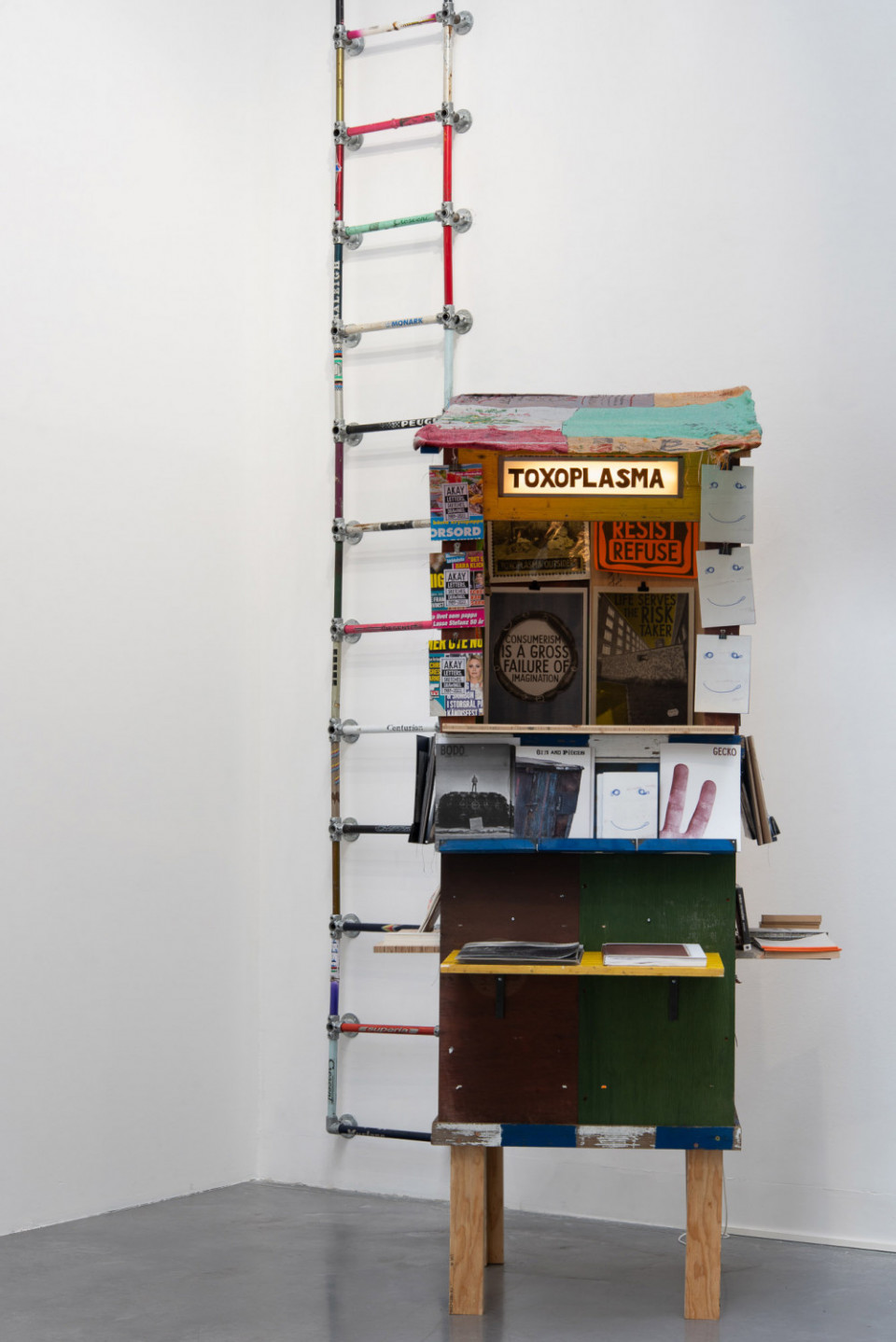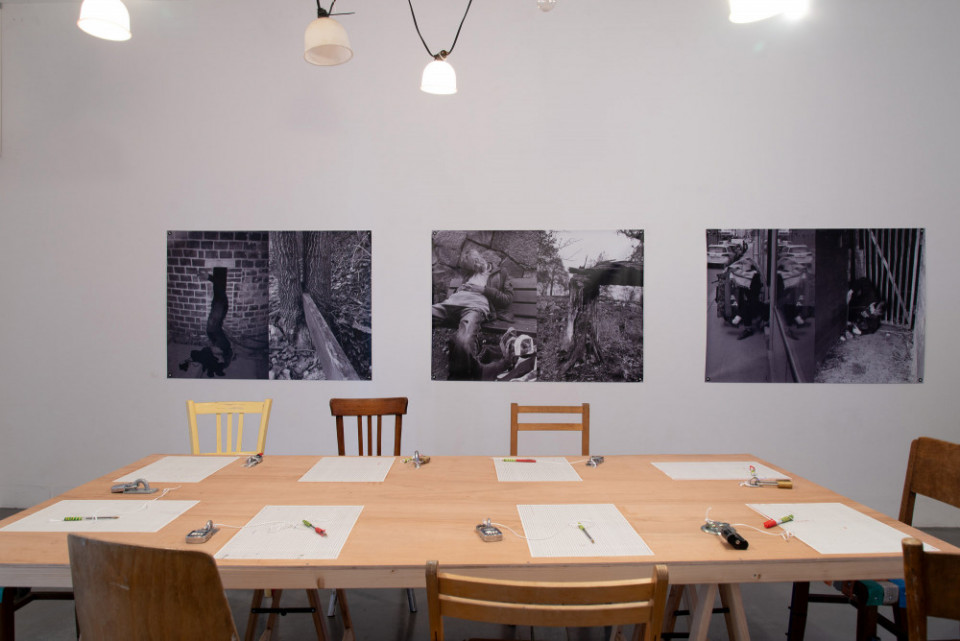Toxoplasma
Bric-à-brac
Exposition
Bac à sable #31
Toxoplasma, Bric-à-brac
“Like everywhere else, façades whitened by thermal fulgurations crumble like wet chalk. Statues’ faces blow away in the gusts of wind, like fine ashen powder, condemning gods and famous men to anonymity. Frescoes and architectural details themselves fade. Window panes melt into glass stalactites2”.
The Bric-à-brac exhibition brings together heterogeneous processes and works. It has built itself by assembling a succession of invitations: from 19, Crac to the Juste Ici association in Besançon as part of the 12th edition of their Bien Urbain festival, from Juste Ici to the Swedish artist duet Akay and Olabo now known as Toxoplasma, from Toxoplasma to multiple facets of the territory right down to the visitors.
Toxoplasma’s practice blends into the rhythm of everyday life. It is carried out most of the time according to principles of “discreet violation3”, indexical and anonymous. She explores marginal spaces such as abandoned warehouses, empty offices and disused stores. These post-industrial environments are the backdrop for explorations, experiments and artistic creations rooted in urban space.
The artists are both historical protagonists and heirs to the urban art of the 1970s4, combining illegality, subversion, ephemerality and playfulness. Their posture, which embraces the techniques of parasitization, detour and telescoping, is deliberately conceived in friction with the environment of intervention in order to thwart the institutionalization that threatens previously marginal practices, and to break with the cycle of “fascination, repulsion, destruction, expiation5” that actors•ices in this field have been observing for several decades.
Indeed, it is in the unresolved ambiguity and dissonance of these gestures that lies the resistance to any categorization of these practices, as well as a certain poetics that reveals “an experience […] of broken windows, the wandering of bodies in motion, an attraction to perspectives without light, a romanticism of vandalism that takes as much care of things as it does of damaging them.], a fascination with the visible or invisible languages that confront the precarious matter of reality, shaping themselves with it while transforming it6”. Their practice, at the crossroads of urban exploration, post-industrial craftsmanship, civil disobedience and humor7, offers infinite possibilities for interaction between audiences and relegated spaces. By taking a contrarian look at these forgotten zones and their fertile potential, they succeed in conveying their alternative, anti-establishment essence, acting as revelators of the poetics of these heterotopias8.
The public space of an art center, understood as a laboratory for experimentation, constitutes another kind of playground for the duo, who are also used to the “exhibition medium”. Here, their work can take the form of in situ installations, a collection of gestures and actions performed during previous “dérives9”, traces of which are preserved in videos or photographs. Their works also include collages, interactive sculptures, constructions and scenographies, most of them based on found or salvaged materials. These visual creations “cobbled together” from their finds reflect not only an artistic posture, but also an art of making, as the artists in their daily lives also live by recycling and reactivating the remnants of contemporary permanent overproduction.
Indeed, the duo now live and work from three locations in the same Stockholm district, which form the common ground for their artistic productions. For several years now, following a principle of “cultural poaching10”, they have been giving new life on a daily basis to abandoned places not intended for “domestic” use, by cleaning and converting them: an old covered bus stop turned into a greenhouse, workshop and library; a tower now an office and small exhibition gallery; an advertising totem converted into a hut.
In this way, Bric-à-brac is also an exhibition conceived as a return trip between two geographies: one that the artists master and practice on a daily basis, where they live and work; the other discovered and surveyed on a one-off, ephemeral basis, host to an artistic project. Their particular approach to industrial wastelands, marginal urban areas and the dregs of consumer society was also applied to this second locality. The diverse realities of the post-industrial, Pays de Montbéliard generated a rich dialogue with their practice of public art, which “needs/provokes and creates conviction, movement, contradiction, sincere interest, dynamics, conflict, contact11”.
The ensemble features elements gleaned from Montbéliard and Stockholm. Cars, bicycle frames, padlocks, models of their living spaces, images of their performance or architectural actions, all become fragments of a succession of monumental, indexical or even hidden constructions; pieces of a narrative linked to their urban explorations and to be completed by the imaginations of those who visit the exhibition. The videos produced in the Pays de Montbéliard, featuring several sequences in which the artists are seen climbing over spaces that are a priori impassable, or walking on palisades and fences, seem to condense the “spirit” of a work seeking a balance between architectural appropriation and an artistic approach situated through action. In many ways, the work is reminiscent of a certain Orwellian dystopian aesthetic that has been widely explored by artists since their early days.
Bric-à-brac is built performatively, between precariousness and ephemerality, where each space is conceived as a situation, “a moment in life, concretely and deliberately constructed by the collective organization of a unitary atmosphere and a set of events12”. These events are artistic propositions, like a “minimal (and maximum) unit for exhibiting usual objects handled in a very everyday way, as a counter-proposal to the aesthetics of the white cube13”.
David Demougeot et Adeline Lépine
Curators of the exhibition
_____
- Since 2023, during the summer months, 19, Crac has been exploring its potential as a public space. The exhibitions hosted during this period are conceived partly as a playground for artists and audiences, presenting “sandbox” works to be activated. The term evokes both children’s play equipment in parks and a type of video game. These “sandbox” games are essentially characterized by the absence of imposed objectives. In 2023, The Outsiders Collective, based in Utrecht (Netherlands), was responsible for the first of these, entitled La Ville en Jeux; the second, in 2024, was conceived by the Assemble Collective, based in London (UK), and was entitled Blood in the Machine. ↺
- Serge Brussolo, Procédure d’évacuation immédiate des musées fantômes, Denoël, collection Présence du Futur, 1987. English translation suggested by the authors of the press release. ↺
- The expression was coined by the American artist Gordon Matta-Clark (1943-1978) who, despite his short career due to his premature death, had a resounding influence on both visual and urban artists, following in the footsteps of the Land Art artists to whom he was close (Robert Smithson, Walter de Maria, Michael Heizer among others). He is known for his deconstruction of architectural space through the principles of perforation, amputation and dissection of the walls, windows, floors and doors of buildings slated for demolition. The expression “discreet violations” was used by the artist in an interview with Judith Russi Kirshner in Chicago in 1978. (“Interview with Gordon Matta-Clark” in Gordon Matta-Clark, cat. exhibition : Valence, Marseille, London, 1992-1993). ↺
- In Photograffi(ti)es d’Expressions Murales : Pierres Philosophales (Volume 1) - Collectif des 12 Singes, 2010 - it is argued that the availability of enamel paints sold in the form of aerosols makes it possible and easy to spread a certain practice and aesthetic of graffiti (which, as we know, dates back to antiquity). It developed in the same movement as other artistic proposals that also seized public space, such as the Fluxus movement, for example, and for which “Art shifted away from the specialized object in the gallery to the real urban environment” (Allan Kaprow, Essays on the Blurring of Art and Life, University of California Press,1993.). ↺
- Quote from Rafael Schacter’s article, From pollution to purity: The transformation of graffiti and street art in London (2005-17), in which he cites French sociologist, anthropologist, philosopher and theologian Bruno Latour (1947-2022) and his essay Iconoclash. In a way, the primary act of urban art is an iconoclash that sows doubt as to whether the action is “destructive or constructive”. In this article, Schacter laments the institutionalization of graffiti in London, from a political and marginal practice to a decorative art in some respects. dropbox.com ↺
- Hugo Vitrani, excerpt from the press release for the group exhibition La morsure des termites from 16/06/2023 to 07/01/2024 at the Palais de Tokyo, attempting “a speculative rereading of art history seen through the prism of graffiti”. ↺
- The artists cite Italian artist Maurizio Cattelan (b. 1960), known for his work blending provocation, irreverence and derision, as one of the contemporary visual practices they enjoy following and consulting. ↺
- According to the French philosopher Michel Foucault (1926-1984), heterotopia refers to the physical location of utopia. These are real spaces that house the imaginary (children’s huts) and/or are also used to isolate. Foucault refers to the cemetery, the asylum, the penitentiary, the retirement home, etc. as heterotopias. These are also places designed to accommodate specific actions and uses, “other places” that within society are governed by rules of their own. ↺
- “The concept of dérives (drifting) is indissolubly linked to the recognition of psychogeographical effects, and to the affirmation of a playful-constructive behavior, which contrasts in every way with the classic notions of travel and strolling. One or more people engaged in drifting give up, for a more or less long period, the reasons for moving and acting that they generally know (…) to let themselves go to the solicitations of the terrain”. Guy Debord, Internationale Situationniste, N°2, 1958. ↺
- In French, “braconnage culturel”: users are constantly hijacking, consciously or unconsciously, the originally intended uses of public spaces. They “invent the everyday through the arts of making, subtle ruses, tactics of resistance by which they hijack objects and codes, reappropriate space and use in their own way (so that) everyone tries to live the social order and the violence of things as best they can.” Michel de Certeau, L’invention du Quotidien, 1. Arts de faire, Gallimard, Folio Essais, 1980. English translation suggested by the authors of the press release. ↺
- Extract from one of the many explanatory panels created by artist Thomas Hirschhorn in connection with his artistic process, research and achievements. Mentions are from the Schema: Art Public Space, 2016-2022 available on his website: thomashirschhorn.com/maps-schemas ↺
- Unsigned, members of the Situationist International, “Definitions”, in Internationale situationniste, N° 1, 1958. ↺
- Extract from Elisabeth Lebovici’s definition of the notion of Event in the work of American artist George Brecht (1926-2008). Brecht, who believed that “the most important events are the little things that happen in the street”, was particularly interested in randomness, following on from his studies with John Cage. The Events are a proposal to the spectators, to read differently the possibilities of everyday life. Through a system of notation or score, Brecht suggests possible outcomes of simple combinations between objects and actions. For example, one of the 1960 Chair Events associates a cane and an orange with a white chair. Lebovici’s December 8, 2008 article can be viewed on her online blog, Le beau vice ↺
Infos utiles
The Bric-à-brac exhibition is the result of a collaboration with the Juste Ici association and is part of the Bien Urbain 2025 festival.
It was produced thanks to the support of La Recyclerie des Forges Vélo - Ensemblier DéFI à Audincourt and in partnership with Jaqu’auto, specializing in the treatment of end-of-life vehicles (ELV) and the sale of spare parts since 1976. www.jaquauto.com
As such, part of Toxoplasma’s video work is presented in Besançon at the same time, thanks to Mobilo, Juste Ici’s traveling structure, which moves to a different location in Besançon every day during the festival.
The artists would like to thank in particular TokyoBuild, Alicia Donat-Magnin, Rae.




